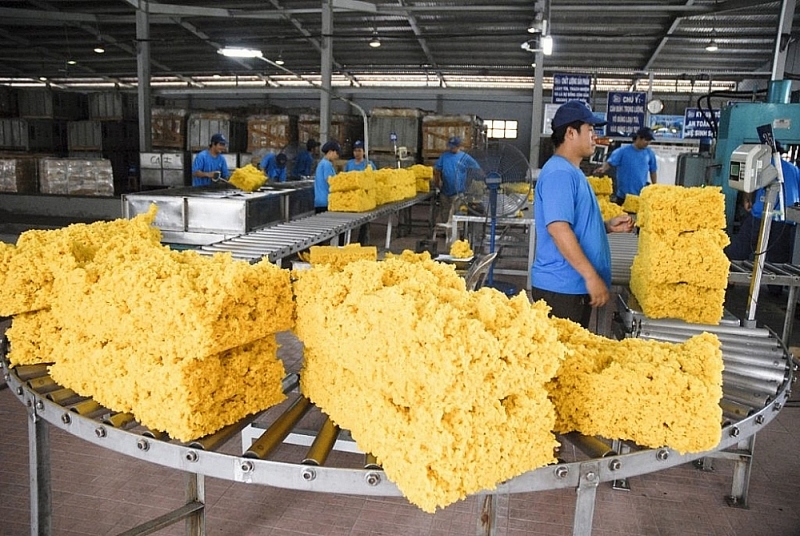 |
| Currently, the certification mark “Vietnamese Rubber” has been protected in five markets: Taiwan, India, China, Laos, and Cambodia |
Facing many difficulties
According to the General Department of Customs, natural rubber exports in the first three months of 2023 reached 381,788 tons, equivalent to US$531.3 million. However, compared to the same period in 2022, rubber exports decreased by 6.1% in volume and 25.7% in value, showing a sharp decline in rubber export prices in the first months of the year. As a result, export turnover for rubber products decreased by 13.4% to US$238.3 million.
According to the Vietnam Rubber Association (VRA), the competition between natural rubber-producing and exporting countries is becoming fierce in terms of price, product quality, commercial reputation, and ability to meet strict sustainability standards. Furthermore, the structure and types of Vietnamese natural rubber heavily depend on the Chinese consumer market and only partially meet the needs of other markets. Therefore, it is difficult for Vietnam to penetrate other large markets such as the US and Japan.
Meanwhile, the national management system for the quality of natural rubber is not uniform across the country, and there is no competent authority to manage the quality of smallholder rubber. Moreover, Vietnam has a national standard for the output of natural rubber products but no national standard for input materials. Therefore, there is no legal basis to prevent the mixing of impurities into raw materials, affecting the quality of rubber latex processing factories.
Additionally, Vo Hoang An, General Secretary of the VRA, said that according to the signed free trade agreements, natural rubber imported into Vietnam enjoyed a tax rate of 0%. This will encourage businesses to prioritize importing sources from Thailand, Malaysia, and Indonesia due to guaranteed quality and diverse types. This will create competitive pressure on domestic rubber sources.
The rubber finished product processing industry also has difficulty competing with imported products that are not controlled in price. There is still a lack of technical barriers in trade to prevent poor-quality goods from being imported from other countries, causing damage to consumers and unfair competition with domestic goods. Most of the raw materials for rubber products have to be imported, so they depend on overseas supplies. Moreover, the high import tax rate increases costs and reduces competitiveness compared to other countries. The rubber industry also faces a shortage of qualified and experienced human resources in the rubber product processing industry.
Focus on the two main pillars
The International Rubber Study Group (IRSG) forecasted that global natural rubber consumption would increase by 2.1% in 2023. However, the long-term sustainable growth of the rubber industry depends on the development of the Russian-Ukrainian conflict and the real growth results of China in the coming time.
The global demand for natural rubber is still in an upward trend, and the supply-demand gap is a great opportunity for Vietnam to increase natural rubber output and export turnover. Besides, the rubber industry has many advantages when recognized as a “multi-purpose tree”. It has contributed to the country’s economic development, improved socio-economic conditions for rural areas, and greened bare land and poor forests to protect the environment.
In that context, to solve the challenges, the rubber industry identifies promoting sustainable development and focusing on building industry brands as two main pillars to meet market trends, international customer requirements, and enhance product value. Many businesses are trying to achieve certificates of sustainable forest management and chain of custody certification for rubber plantations.
For example, at Vietnam Rubber Group, Truong Minh Trung, Deputy General Director, said that as of March 2023, 26 members of the group have completed the sustainable forest management plan with an area of 274,320 ha; 17 members are certified for sustainable forest management according to the VFCS, PEFC-FM standards with nearly 110,000 hectares of rubber. And 31 natural rubber processing plants and two wood factories have obtained the chain of custody certification (PEFC-CoC). There is also one member who has been audited for controlled source certification. In 2022, the companies under the Vietnam Rubber Group sold 41,500 tons of PEFC-certified rubber latex to customers.
Currently, the Government’s policy is not to expand the rubber area. Hence, increasing productivity by using high-yielding varieties, mechanization, applying science and technology besides branding, and continuously researching sustainable development are the factors that help Vietnam’s rubber industry to increase its competitiveness in the international market.
Therefore, An said that to develop the certification mark “Vietnamese Rubber”, the VRA would continue to monitor the periodical, renew the trademark annually, and encourage members in Laos, Cambodia, and the private sector to register. In addition, the association will carry out protection registration in some key markets, research and propose ministries and agencies to have policies to support enterprises and members to gain trademarks to strengthen their reputation and improve the quality of the Vietnam Rubber brand.
The VRA will continuously coordinate with domestic and foreign NGOs to conduct research, surveys, and projects related to sustainable development in a favourable direction for members and the rubber industry. Additionally, promote and support members and businesses in the rubber industry to implement advanced management methods, conduct business in compliance with international practices, and apply Industry 4.0 towards sustainable development.
